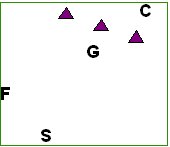COLLECTIVE SPORTS
UNIT: CRICKET
LESSON: 3
Contents:
OVERARM BOWLINGAPPARATUS: Tennis balls, light cricket balls, markers/cones/wickets, bats, cones.
ORGANISATION
CONTENT
TEACHING POINTS
In fours: feeder (F), striker (S), goalkeeper (G) and collector (C).
Set up two goals.

WARM UP:
1- Go for goal
The striker with the bat is 5 m away from the goalkeeper, who is in front of two goals. The feeder drop feeds the ball to the striker or uses a tee. The striker has to hit the ball below head height ten times and try to do as many goals as possible. How many goals in 10 hits? The collector passes the ball back to the feeder.
How to improve
• Keep the ball below head height.
• Watch the path of the ball.
• Be ready to move if the tee is in the wrong place.
Challenges and changes
• Can you hit the ball to the corner of the goal?
• Can you hit the ball to different sides?
Easier
• Ask the goalkeeper to stay near the goal.
• Use bigger goals.
• Hit from a tee or a rolled ball.
Harder
• Goalkeeper can move out when the ball is fed.
• Use smaller goals.
Individually
- First, children are spaced out and everyone does the activity at the same time.
- Then, they do the activity again, one after the other. If in one class there are lots of children, put them into groups of 6, and one of each group does the activity at the same time.
MAIN PART:
Skills: body position – run up
2- Go up!
They have to run and jump to land side on feet apart as if straddling a river. Pupils should land sideways on to the direction they were running before the jump. Both feet should land on floor simultaneously.
Individually
(as above)3- Running and jumping as if to grasp a branch above your head and landing as above, with arms up above your head. Both arms should be raised high above head as child jumps as if grasping branch.
Individually
(as above)
Skills; overarm bowling
4- Overarm bowling; individually
As for 2, except that each person should be holding a ball and when they land should go through above position, but land inside on bowling position as per lesson 2.

5- Overarm bowling; in partners
Pupils now work in pairs
As for 3 except that pupils now run (approximately 5m), jump into side on position and bowl to partner so that the ball bounces once. Bowling distance is approximately 20m.
Children may be encouraged to run up steadily, not too quickly. As they jump, their legs should cross with one leg passing in front of the other whilst getting side on.
On landing in side-on position bowler will be leaning slightly backwards on back leg before performing windmill action.
In groups of 4.

GAME;
6- BOWLING SHUTTLE
Children are in groups of 4; three are bowlers and the other wicket keeper.
• Each bowler takes it in turn to bowl at the wickets with one of the group acting as wicket keeper.
• Each bowler bowls ten balls and then the wicket keeper is changed.
• This is repeated until all bowlers have bowled thirty balls.
• Encourage bowlers to bowl so that the ball bounces once only.
• Ensure ball is bowled with a straight arm.